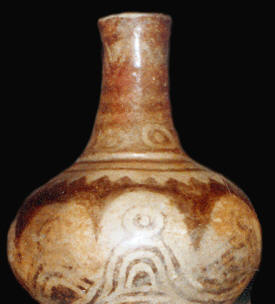|
This small
negative painted cup appears to be a ritual item that was made for a
very specialized use. It's exceptionally well made by someone who was skilled in making ceramic
vessels. The surface is very smooth and polished. Its thickest
measurement is at the base and then tapers nicely to a very even edge
that measures less than 1 mm. It measures 2 3/4 inches (7 cm) in
diameter and 1 inch (2.6 cm) high.
|
|
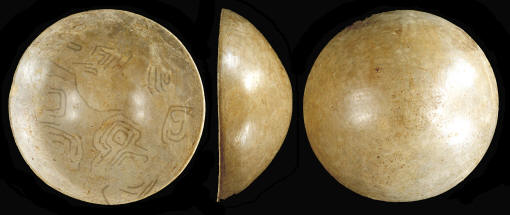
CLICK ON PICTURE FOR LARGER IMAGE
NEGATIVE PAINTED CERAMIC CUP
MISSISSIPPIAN PERIOD
MADISON & ST. CLAIR COUNTIES,
ILLINOIS
PRIVATE COLLECTION
This picture shows the small negative painted cup in three views,
top, bottom and edge. Some of the engraving has been digitally
enhanced. The painted design seems to be very complicated. Further
investigation with better technology might determine more of the
pattern.
This small cup is
exceptionally well made by someone who was skilled in making ceramic
vessels. The surface is very smooth and polished. Its thickest
measurement is at the base and then tapers nicely to a very even
edge that measures less than 1 mm. It measures 2 3/4 inches (7 cm)
in diameter and 1 inch (2.6 cm) high. |
|
|
One of the most important features about this
cup is the negative paint technique by which it was decorated. The
complicated design is painted on both the inside and outside surfaces.
Carl Chapman describes the procedure as, "It is achieved by painting the
design with a substance that resists taking the color. Thus when the
color is applied, only the untreated areas receive it." Negative painted
ceramics from the Cahokia area, or anywhere else in the Mississippi
Valley region, are rare. Most of the known examples of negative painted
pottery from the Cahokia area have been reported from mound 34. |
|
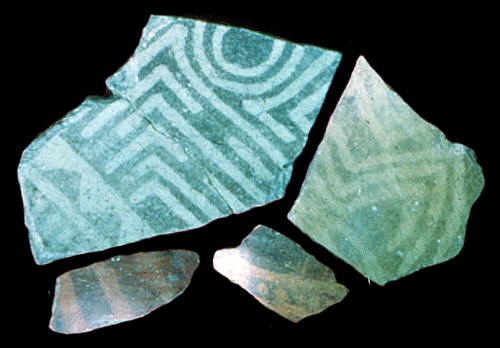
PHOTO BY GREGORY PERINO
NEGATIVE PAINTED POTSHERDS
MOUND 34---THE CAHOKIA MOUNDS
SITE
MADISON & ST. CLAIR COUNTIES,
ILLINOIS
Very little
evidence of negative painted ceramic vessels have been found in the
area on or around the Cahokia Mounds site. Most of the examples
pictured here are reported to have been found at mound 34 at
Cahokia. They represent part of only a handful that are known from
the site. The interesting feature, as it relates to the small
negative painted cup in this article, is the fragment that is
painted with ninety degree angles within ninety degree angles. This
is a similar design that is found on the small cup. |
|
|
Mound 34 is a
ceremonial platform mound that was built in several stages. Its
considered to be a place where rituals were once being performed. This
site has produced many exotic artifacts that relate to the Southeastern
Ceremonial Complex or Southern Cult. Some of the more interesting
artifacts found there include engraved whelk shell cup fragments,
drilled sharks teeth, flaked stone sharks teeth, arrow points made of
bone and negative painted potsherds. |
|
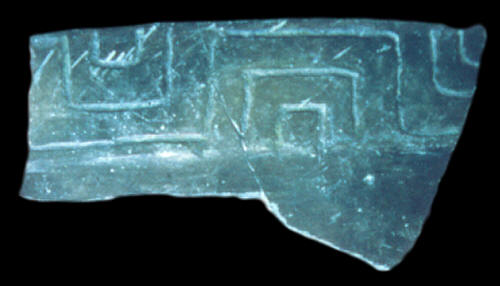
PHOTO BY GREGORY PERINO
ENGRAVED POTTERY SHARD
CAHOKIA MOUNDS SITE
MADISON & ST. CLAIR COUNTIES,
ILLINOIS
This engraved pottery fragment was found by Gregory Perino in a
large pit, several years ago, just west of mound 34. It's part of
what once may have been a pot the size of a bushel basket. It's most
interesting feature is the engraved, square-within-style, design
pattern. This is very similar to the design on the small negative
painted cup. |
|
|
The design on the surface of this
negative painted cup is very faint but
enough can be seen to know that it's very complex. The main
design feature seems to be geometric in form with repeated images of
squares within squares. Similar design patterns have been found on
broken potsherds from Cahokia. These are in the form of both engraved
and negative painted ceramics. The geometric forms are lines of ninety
degree angles within ninety degree angles. Several of these have been
found at mound 34.
Other design patterns on the cup might be
revealed by further study and more technical equipment. |
|
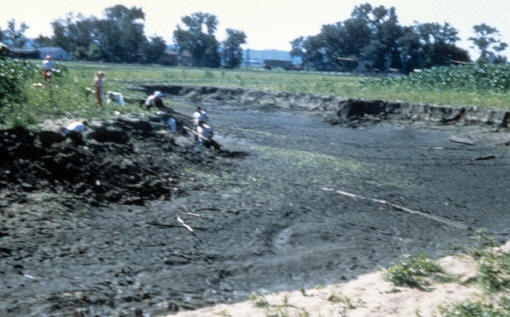
PHOTO BY GREGORY PERINO
CLICK ON PICTURE FOR LARGER IMAGE
CAHOKIA SITE FLOOD OF 1954
BETWEEN MOUNDS 19 AND 20
CAHOKIA MOUNDS SITE
MADISON AND ST. CLAIR COUNTIES, ILLINOIS
This picture was taken in 1954 by Gregory Perino. It shows the
extensive damage the "great flood" of that year did to one of the
fields on the Cahokia Mounds site. Large numbers of artifacts are
reported to have been found in these washouts after the flood, and
in fact, several people can be seen in the picture looking for
artifacts. It's possible that the negative painted cup described in
this article may have been found during this event. It's so delicate
that it was probably found somewhere in a washout after a heavy rain rather than
brought to the surface by heavy farm equipment. |
|
|
This small cup is the only complete example of a
negative painted ceramic vessel that's been reported from southern Illinois,
in the area
around the Cahokia Mounds site. Because of its rare form of painting
technique, design pattern and skill in manufacture its likely that it
relates to ceramic vessels that were once used in some type of
ceremonial context. It's design pattern also relates to patterns found
on pottery from Cahokia. It seems likely that this negative painted cup
is related to the Cahokia Mounds site in some way and was once used in
some type of ritual activity. |
|
"REFERENCES"
1964, Chapman, Carl H. & Chapman,
Eleanor F., "Indians And Archaeology Of Missouri, pp. 69 & 296.
1976, Hathcock, Roy, "Ancient Indian Pottery Of The Mississippi River Valley," p. 14.
1989, Fowler, Melvin, "The Cahokia Atlas, A Historical Atlas Of
Cahokia Archaeology," p. 54.
1996, Hilgeman, Sherri L., "New Fire Ceremony Plates At The Angel Site,"
Glenn A. Black Laboratory Of Archaeology, Indiana University, web site.
2004, Steponaitis, Vincas P. and Knight, Vernon J., Jr., Hero Hawk And Open
Hand, "Moundville Art In Historical And Social Context," p.
174.
Personal communications with Larry Kinsella.
|
|
RECENT
LISTINGS HOME
ORDERING |
